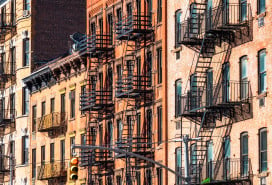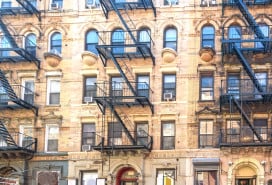Should NYC adopt backyard "DADU" houses, the ultra-cute solution to overcrowding?

It would seem that New York living is all about cramming as many people into as little space as possible, so when we heard about "DADU" houses—detached accessory dwelling units, or small backyard houses that are catching on in Seattle and Portland as sources of rental income and a solution to density issues—our first thought was: Why isn't anyone doing this in New York?
As it turns out, it's because building this kind of structure is completely and utterly illegal in NYC, and those laws aren't likely to change any time soon. While the Seattle Times reports that city officials there are working to loosen rules to make these structures easier for homeowners, here in New York, building a miniature home in your backyard flies in the face of our longstanding zoning laws.

"When you have a residential building with bedrooms or living rooms facing the rear of the property, you want to make sure they have a minimum amount of light and air, which has been defined as 30 feet of open space," explains land use attorney Howard Goldman. In most cases, he says, this means a 30-foot backyard with no structures or obstructions. On top of that, Goldman points out that smaller residential lots tend not to have a high floor area ratio—in other words, the amount of total space the property is allowed to take up on the lot—and that with standalone houses, the allowable floor area ratio is usually used up by the existing building, meaning there'd be none left over for a residential backyard structure.
"Any time you're building residential, you need a 30-foot backyard, end of discussion," concurs architect Michael Zenreich. "Though housing code allows for a detached garage, tool shed, or other agricultural shed in the backyard." (As we've written previously, it's legal to build a shed of up to 120 square feet without filing paperwork in the city or adding extra foundations in the yard.) Still, the city takes this stuff seriously: "I have a friend who tried to put a tree house in the yard, and he got it done, but it probably took a year to get approved," says Zenreich.
That said, you will occasionally find existing backyard structures in older buildings that were built before the current laws came into effect, often as rental properties that generate incomes from owners of the larger house on-site. "They’re not common. You’re only going to see them in the downtown neighborhoods, mostly in the Village and Soho," says Zenreich. But for a property owner, the setup is fairly ideal: Generate rental income on your property, without the invasion of privacy that comes with sharing an actual building with your tenant.
While all of these laws initially came into place to protect renters (and prevent tenement-style overcrowding), we're not the only ones who've thought of DADUs as a way to ease the pain of overcrowding—the Center for an Urban Future recommended that NYC adopt this practice in a 2013 policy report.
In any case, if these cute little houses ever come to New York, it'll be a long way off. "It would require a change to the text of the zoning resolution which would have to go through the land use procedure process, and approved by community boards, the City Council, etc." says Goldman.
Related:
I love my carriage house rental behind a building. Could we buy it on its own, and how?























